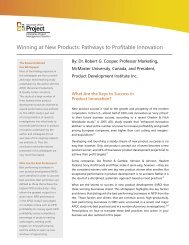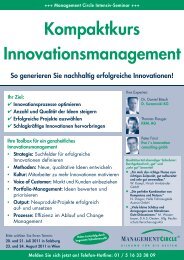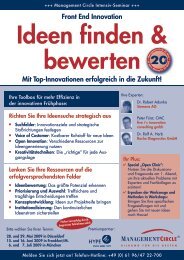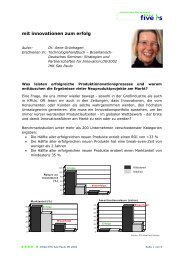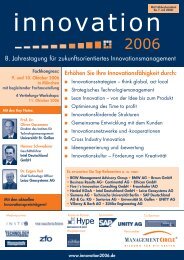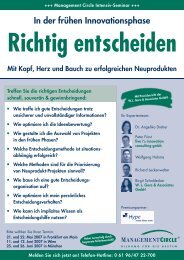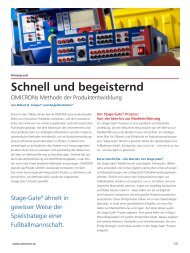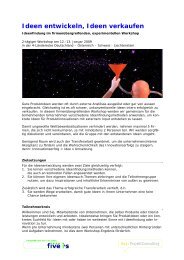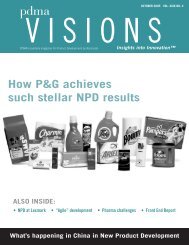The seven principles of the latest Stage-Gate
The seven principles of the latest Stage-Gate
The seven principles of the latest Stage-Gate
You also want an ePaper? Increase the reach of your titles
YUMPU automatically turns print PDFs into web optimized ePapers that Google loves.
18 ❘ MM March/April 2006<br />
<strong>The</strong> <strong>seven</strong> <strong>principles</strong> <strong>of</strong> <strong>the</strong><br />
<strong>latest</strong> <strong>Stage</strong>-<strong>Gate</strong> ® method add up<br />
to a streamlined, new-product<br />
idea-to-launch process.<br />
BY ROBERT G. COOPER
Have you ever wondered why<br />
some companies make product<br />
innovation seem so easy—generating<br />
one big winner after ano<strong>the</strong>r? Here is<br />
a startling fact: New-product development<br />
(NPD) productivity in <strong>the</strong> top performing<br />
company is five times what it is in <strong>the</strong><br />
average company. <strong>The</strong> top performer gets<br />
five times as much new-product output for<br />
<strong>the</strong> same investment, according to <strong>the</strong><br />
Innovation Excellence Study 2005 conducted<br />
by Arthur D. Little (ADL). For <strong>the</strong> rest <strong>of</strong><br />
us, developing a steady stream <strong>of</strong> successful<br />
new products is a real challenge.<br />
Major Productivity Gaps<br />
<strong>The</strong> concept <strong>of</strong> productivity is simple:<br />
<strong>the</strong> most bang for <strong>the</strong> buck. In product<br />
development, it is output (new-product<br />
sales or pr<strong>of</strong>its) divided by input (research<br />
and development or NPD costs and time).<br />
Reprinted with permission from Marketing Management, March/April 2006, published by <strong>the</strong> American Marketing Association.<br />
<strong>The</strong> ADL study provides insights into<br />
NPD productivity by industry. It looks at<br />
output (five-year sales from new products<br />
as a percentage <strong>of</strong> company sales) and<br />
input (research and development spending<br />
as a percentage <strong>of</strong> company sales). One<br />
startling conclusion is <strong>the</strong> difference in<br />
productivity between top performers and<br />
<strong>the</strong> rest, regardless <strong>of</strong> industry. On average,<br />
<strong>the</strong>re’s an almost 1,200% difference<br />
between <strong>the</strong> most productive (top 25%<br />
<strong>of</strong> companies on this metric) and least<br />
productive (bottom 25% <strong>of</strong> companies on<br />
this metric). And in some industries, <strong>the</strong><br />
difference is even greater. For example,<br />
<strong>the</strong> top 25% pharmaceutical companies<br />
are 31 times more productive in NPD<br />
than <strong>the</strong> bottom 25%. What are <strong>the</strong>se<br />
high productivity companies doing so<br />
differently, and can your company learn<br />
from <strong>the</strong>m?<br />
MM March/April 2006 ❘ 19
EXECUTIVE<br />
briefing<br />
Many businesses use <strong>the</strong> <strong>Stage</strong>-<strong>Gate</strong> ® process—which this author introduced in 1988—to<br />
conceive, develop, and launch new products. As pr<strong>of</strong>icient companies have implemented, modified,<br />
adapted, and improved <strong>the</strong> methodology, it has morphed into a faster, leaner, and more<br />
effective tool. <strong>The</strong> next generation process, or NexGen <strong>Stage</strong>-<strong>Gate</strong>, builds in <strong>seven</strong> <strong>principles</strong> <strong>of</strong> lean, rapid, and pr<strong>of</strong>itable<br />
new-product development to maximize productivity in product innovation.<br />
Maximizing Productivity<br />
Seven key <strong>principles</strong> <strong>of</strong> lean, rapid, and pr<strong>of</strong>itable NPD are<br />
common denominators <strong>of</strong> high productivity businesses in<br />
product innovation. <strong>The</strong>y are very much fact-based and were<br />
uncovered in benchmarking and best practice studies <strong>of</strong> top<br />
performing companies. <strong>The</strong>se <strong>principles</strong> were developed from<br />
a long tradition <strong>of</strong> solid research, culminating in <strong>the</strong> most<br />
recent American Productivity & Quality Center (APQC) study<br />
<strong>of</strong> best practices in product innovation. Our research shows<br />
that companies or project teams that employ <strong>the</strong>se <strong>principles</strong><br />
achieve superior performance results, and that poor performers<br />
tend to ignore <strong>the</strong>m (see Exhibit 1). Integrating <strong>the</strong> following<br />
<strong>principles</strong> <strong>of</strong> NPD into your new-product methodology<br />
results in a next generation idea-to-launch process, or NexGen<br />
<strong>Stage</strong>-<strong>Gate</strong> ®. (<strong>Stage</strong>-<strong>Gate</strong> ® is a registered trademark <strong>of</strong> <strong>the</strong><br />
Product Development Institute Inc.)<br />
Customer focused. Developing and delivering new products<br />
that are differentiated, solve major customer problems,<br />
and <strong>of</strong>fer a compelling value proposition<br />
to <strong>the</strong> customer are <strong>the</strong> top drivers <strong>of</strong><br />
NPD success and pr<strong>of</strong>itability. <strong>The</strong> product<br />
or service must possess a “wow” factor<br />
or a little excitement, something that<br />
is missing from most new products. But<br />
conceiving such a product seems beyond<br />
<strong>the</strong> reach <strong>of</strong> many companies. Indeed, a<br />
major reason for <strong>the</strong> decline in U.S. NPD<br />
productivity is that many company<br />
pipelines simply lack stimulating and<br />
genuine new products. Instead, <strong>the</strong>y are<br />
focused on tweaks, modifications, and<br />
extensions with little real competitive<br />
advantage.<br />
<strong>The</strong> quest for unique, superior products<br />
begins with a thorough understanding<br />
<strong>of</strong> <strong>the</strong> customer’s unmet and <strong>of</strong>ten<br />
unarticulated needs—through in-<strong>the</strong>field,<br />
voice-<strong>of</strong>-customer work. This means<br />
that <strong>the</strong> entire team—technical, marketing,<br />
and operations people—interviews<br />
and interfaces with real customers/users,<br />
and learns <strong>the</strong>ir problems, needs, and<br />
challenges firsthand. This is quite differ-<br />
20 ❘ MM March/April 2006<br />
ent from relying on <strong>the</strong> salesperson or product manager to<br />
speak for <strong>the</strong> marketplace; such information is <strong>of</strong>ten filtered,<br />
biased, and incorrect. <strong>The</strong> result is that <strong>the</strong> customer becomes<br />
an integral part <strong>of</strong> <strong>the</strong> entire process: scoping, product definition,<br />
development, validation, and beyond.<br />
Front-end loading. Due diligence in <strong>the</strong> early days <strong>of</strong> a<br />
project pays <strong>of</strong>f; just ask a venture capitalist. A good dose <strong>of</strong><br />
<strong>the</strong> right up-front homework pays for itself tenfold, saving<br />
time and producing higher success rates. Smart managers<br />
demand such preparation on projects: fact-based market, technical,<br />
and business assessments. This homework is not excessive;<br />
ra<strong>the</strong>r, it yields just enough vital information for making<br />
<strong>the</strong> go-to-development decision, and for sufficiently defining<br />
<strong>the</strong> product and project to proceed. It’s also instrumental in<br />
generating a winning product.<br />
Spiral development. Things change. Often a team charges<br />
into development with a product definition based on information<br />
that was right at <strong>the</strong> time, or thought to be right. But it<br />
■ Exhibit 1<br />
High productivity businesses practice <strong>the</strong> <strong>seven</strong> NPD <strong>principles</strong><br />
1. Customer focused<br />
2. Heavy front-end homework<br />
before development begins<br />
3. Spiral development—loops with<br />
users throughout development<br />
4. Holistic—effective<br />
cross-functional teams<br />
5. Metrics, accountable teams,<br />
pr<strong>of</strong>it/loss reports for<br />
continuous learning<br />
6. Focus and porfolio management<br />
7. Lean, scalable, and adaptable<br />
<strong>Stage</strong>-<strong>Gate</strong> process<br />
Source <strong>of</strong> data: APQC study<br />
7.7%<br />
10.3%<br />
9%<br />
15.4%<br />
26.3%<br />
28.2%<br />
25.2%<br />
33.4%<br />
38.5%<br />
44.8%<br />
37.4%<br />
44.8%<br />
40.2%<br />
41.4%<br />
48.3%<br />
54%<br />
58%<br />
62.1%<br />
69%<br />
0% 10% 20% 30% 40% 50% 60% 70% 80% 90% 100%<br />
Percentage <strong>of</strong> businesses<br />
74.2%<br />
■ Low productivity businesses<br />
■ Average productivity businesses<br />
■ High productivity businesses<br />
70.7%
■ Exhibit 2<br />
Spiral development<br />
<strong>Gate</strong><br />
2<br />
A series <strong>of</strong> “build, test, obtain feedback, revise” iterations or loops<br />
Build<br />
business<br />
case<br />
User<br />
needs and<br />
wants<br />
study<br />
Full prop<br />
concept<br />
test<br />
Rapid<br />
protocept<br />
and test<br />
First<br />
protocept<br />
and test<br />
Next<br />
protocept<br />
and test<br />
wasn’t, or <strong>the</strong> market shifted, or a competitive product was<br />
introduced. And when <strong>the</strong> product is developed, it isn’t quite<br />
right for <strong>the</strong> market. Smart teams practice spiral development.<br />
<strong>The</strong>y create <strong>the</strong> first version <strong>of</strong> a product (perhaps a virtual<br />
one) and test it with <strong>the</strong> customer, seeking feedback. <strong>The</strong>n<br />
<strong>the</strong>y use that feedback to produce <strong>the</strong> next, more complete<br />
version—maybe a working model or protocept. <strong>The</strong>se fastpaced<br />
teams remove unnecessary work and quickly move to<br />
finalized products, by forming a series <strong>of</strong> <strong>the</strong>se iterative steps<br />
or loops: build, test, obtain feedback, and revise. <strong>The</strong> loops are<br />
built into <strong>the</strong> entire process, from scoping through development<br />
and into testing. When sketched on a flow diagram, <strong>the</strong>y<br />
appear as spirals (see Exhibit 2).<br />
A holistic approach. Product innovation is very much a<br />
business function (not a research and development activity)<br />
and a team-based endeavor. <strong>The</strong> core team, an effective crossfunctional<br />
group, is <strong>the</strong> No. 1 key to reducing cycle time and<br />
promptly getting to market. Effective cross-functional teams<br />
comprise critical players from different parts <strong>of</strong> <strong>the</strong> organization,<br />
each with an equal stake in and commitment to <strong>the</strong> project.<br />
<strong>The</strong>y remain involved from start to finish, not just for one<br />
phase <strong>of</strong> <strong>the</strong> project. Team accountability—results measured<br />
against success criteria—also is critical for a team to be effective.<br />
A carefully selected champion or captain leads <strong>the</strong> team,<br />
driving <strong>the</strong> project down <strong>the</strong> pipeline to <strong>the</strong> goal, in entrepreneurial<br />
fashion. <strong>The</strong> team’s organization (composition, key<br />
players’ roles and authority, and <strong>the</strong> choice <strong>of</strong> <strong>the</strong> appropriate<br />
team leader) means <strong>the</strong> difference between efficient, time-driven<br />
projects and those that languish and take forever.<br />
Metrics, accountability, and continuous improvement. You<br />
can’t manage what you don’t measure. Many companies are<br />
guilty <strong>of</strong> not measuring <strong>the</strong>ir new-product results, as Exhibit 1<br />
shows. It’s not clear whe<strong>the</strong>r a project was successful (i.e., met<br />
its pr<strong>of</strong>it or launch-date target). And <strong>of</strong>ten, new-product pr<strong>of</strong>-<br />
Test and<br />
validate<br />
<strong>Stage</strong> 2 <strong>Gate</strong> <strong>Stage</strong> 3: Development <strong>Gate</strong> <strong>Stage</strong> 4<br />
3<br />
4<br />
Field<br />
trial,<br />
beta test<br />
itability results for <strong>the</strong> entire company are missing.<br />
Without metrics, teams can’t be held accountable for<br />
results—and continuous learning and improvement is<br />
next to impossible.<br />
Top performing companies establish metrics: <strong>The</strong>y<br />
measure how well individual projects perform by<br />
building post-launch and gate reviews into <strong>the</strong>ir ideato-launch<br />
processes, and hold teams accountable for<br />
delivering promised results against <strong>the</strong>se metrics.<br />
When gaps, difficulties, and weaknesses are identified,<br />
<strong>the</strong>y hold problem solving sessions—focusing<br />
on <strong>the</strong> causes, and identifying corrective actions to<br />
stop recurrence. In this manner, continuous learning<br />
and improvement become an integral, routine facet <strong>of</strong><br />
<strong>the</strong> development process: Every project is executed<br />
better than <strong>the</strong> one before.<br />
Focus and effective portfolio management. Most<br />
companies have too many development projects<br />
under way, and <strong>of</strong>ten <strong>the</strong> wrong ones: <strong>The</strong>y fail to<br />
focus, spreading <strong>the</strong>ir resources too thinly across too<br />
many initiatives, and <strong>the</strong>ir portfolio choices result in <strong>the</strong><br />
wrong mix and balance <strong>of</strong> projects. Consequently, <strong>the</strong>re are<br />
too many low-value projects and <strong>the</strong>y take too long.<br />
Development projects are investments and <strong>the</strong>refore must<br />
be carefully scrutinized and focused through an effective<br />
portfolio-management system. This is achieved with a funneling<br />
approach: Start with many solid new-product concepts,<br />
and successively remove <strong>the</strong> weak ones via a series <strong>of</strong> gates.<br />
This results in fewer projects, but ones with higher value to<br />
<strong>the</strong> company—and a significant improvement in productivity.<br />
Adequate project resources also must be in place. Securing<br />
<strong>the</strong>se is partly <strong>the</strong> result <strong>of</strong> an effective portfolio-management<br />
system, which ensures that <strong>the</strong> pipeline isn’t overloaded.<br />
Planning is ano<strong>the</strong>r facet <strong>of</strong> correctly pulling toge<strong>the</strong>r<br />
resources: accurately estimating <strong>the</strong> resource requirements,<br />
projecting how long key tasks will take, and preparing an<br />
effective “go forward” plan. Finally, <strong>the</strong> needed resources—<br />
people and money—must be secured at <strong>the</strong> important gates.<br />
<strong>Gate</strong>s are not just go or kill decision points, but also resource<br />
allocation and commitment points.<br />
A lean, scalable, and adaptable process. Too many companies’<br />
idea-to-launch processes contain bureaucracy, time<br />
wasters, and make-work activities. Even worse, <strong>the</strong>y contain<br />
rigid procedures and demand too much paperwork, forms,<br />
meetings, and committees—regardless <strong>of</strong> <strong>the</strong> project. If your<br />
new-product process or launch system is more than three<br />
years old, <strong>the</strong>n it probably needs a good overhaul, or an<br />
update at minimum.<br />
<strong>The</strong> ingredients <strong>of</strong> a first-class idea-to-launch system are<br />
clear: Build in <strong>the</strong> aforementioned six <strong>principles</strong>—those factors<br />
that mean <strong>the</strong> difference between winning and losing. Although<br />
<strong>the</strong>se <strong>principles</strong> might seem obvious, <strong>the</strong> majority <strong>of</strong> companies<br />
aren’t practicing <strong>the</strong>m (as Exhibit 1 revealed). Only one-third <strong>of</strong><br />
companies are truly customer focused in <strong>the</strong>ir new-product<br />
MM March/April 2006 ❘ 21
■ Exhibit 3<br />
An overview <strong>of</strong> NexGen <strong>Stage</strong>-<strong>Gate</strong>:<br />
A five-stage, five-gate framework for significant new product projects<br />
Idea<br />
stage<br />
Idea screen<br />
<strong>Gate</strong><br />
1<br />
<strong>Stage</strong><br />
1<br />
<strong>Gate</strong><br />
2<br />
<strong>Stage</strong><br />
2<br />
Discovery Scoping Business<br />
case<br />
efforts, 55% don’t perform adequate front-end homework, and<br />
almost three-fourths lack metrics, team accountability, and continuous<br />
learning in NPD. So go through <strong>the</strong> list in Exhibit 1,<br />
and ensure that each principle becomes ingrained in your<br />
process’ language and method <strong>of</strong> operation.<br />
NexGen <strong>Stage</strong>-<strong>Gate</strong><br />
Most U.S. companies engaged in product development<br />
have adopted and implemented some form <strong>of</strong> stage-and-gate<br />
new-product processes, such as <strong>Stage</strong>-<strong>Gate</strong> (see Exhibit 3). In<br />
<strong>the</strong> APQC study, every top performing company did so, to<br />
drive new products to market. This breaks <strong>the</strong> innovation<br />
process, from idea to launch, into a series <strong>of</strong> stages (typically<br />
about five). In each stage, <strong>the</strong> project team executes a prescribed<br />
set <strong>of</strong> actions, designed to advance <strong>the</strong> project effectively<br />
and efficiently. This set is based on best practices, and<br />
yields a defined package <strong>of</strong> deliverables at <strong>the</strong> end <strong>of</strong> each<br />
stage.<br />
Each stage is preceded by a gate or go/kill decision point.<br />
Here, senior management meets with <strong>the</strong> team, and decides<br />
whe<strong>the</strong>r <strong>the</strong> project should proceed. Each gate has a prescribed<br />
list <strong>of</strong> deliverables—<strong>the</strong> information senior management<br />
needs to make <strong>the</strong> go/kill decision—and a set <strong>of</strong> go/kill<br />
and prioritization criteria, on which to base that decision.<br />
<strong>Gate</strong>s are also where team leaders secure <strong>the</strong> necessary<br />
resources for driving <strong>the</strong> project forward; <strong>the</strong>y get it on senior<br />
management’s radar screen.<br />
<strong>Stage</strong>-<strong>Gate</strong> makes sense, intuitively. It incorporates best<br />
practices that are <strong>of</strong>ten omitted in many companies’ approaches;<br />
yields focus, eliminating poor projects early in <strong>the</strong> process;<br />
makes expectations clear to project teams; encourages a crossfunctional<br />
approach to product development; and appropriately<br />
engages senior management in <strong>the</strong> innovation process as<br />
decision makers and resource providers. Moreover, when<br />
22 ❘ MM March/April 2006<br />
Driving new products to market<br />
Second screen Go to develop Go to test Go to launch<br />
<strong>Gate</strong><br />
3<br />
<strong>Stage</strong><br />
3<br />
<strong>Gate</strong><br />
4<br />
<strong>Stage</strong><br />
4<br />
<strong>Gate</strong><br />
5<br />
<strong>Stage</strong><br />
5<br />
Development Testing Launch<br />
Post launch<br />
review<br />
(PLR)<br />
properly designed and implemented,<br />
<strong>Stage</strong>-<strong>Gate</strong> works. <strong>The</strong> majority <strong>of</strong> top<br />
performing companies in product<br />
innovation—Procter & Gamble,<br />
Micros<strong>of</strong>t, Siemens, and Hewlett-<br />
Packard—have pr<strong>of</strong>iciently implemented<br />
such processes, and witnessed<br />
<strong>the</strong>ir new products going to market<br />
quickly and effectively (see <strong>the</strong> APQC<br />
study). For example, Procter & Gamble<br />
boasted five <strong>of</strong> <strong>the</strong> top 10 best-selling<br />
consumer, nonfood new-product<br />
launches in 2004. Coincidentally, it is<br />
strongly committed to SIMPL, a <strong>Stage</strong>-<br />
<strong>Gate</strong> process like <strong>the</strong> one in Exhibit 3.<br />
Companies can make <strong>Stage</strong>-<strong>Gate</strong><br />
even more effective by moving toward<br />
NexGen processes—which incorporate<br />
<strong>the</strong> six <strong>principles</strong> outlined earlier in<br />
<strong>the</strong> article—and <strong>the</strong>n adding <strong>the</strong> fol-<br />
lowing elements <strong>of</strong> <strong>the</strong> <strong>seven</strong>th principle.<br />
Lean. Smart companies streamline <strong>the</strong>ir NPD processes,<br />
removing waste and inefficiency at every opportunity. Senior<br />
management borrows <strong>the</strong> concepts from lean manufacturing<br />
and applies <strong>the</strong>m to its new-product process to remove waste<br />
in <strong>the</strong> system. By analyzing a map <strong>of</strong> <strong>the</strong> idea-to-launch value<br />
stream, all non-value-added items are removed. Every activity,<br />
procedure, template, deliverable, and committee in <strong>the</strong> current<br />
process is scrutinized: Is it really needed and how can projects<br />
be completed faster and better? Continuous learning and<br />
improvement is a key facet <strong>of</strong> <strong>the</strong> lean method, with postmortems<br />
undertaken at <strong>the</strong> post-launch review to provide<br />
insights. This results in a much more efficient and effective<br />
idea-to-launch method.<br />
Scalable. <strong>The</strong>re is no longer just one version <strong>of</strong> <strong>Stage</strong>-<strong>Gate</strong>.<br />
<strong>The</strong> process has morphed into multiple versions: <strong>Stage</strong>-<strong>Gate</strong><br />
XPress for projects <strong>of</strong> moderate risk, such as improvements,<br />
modifications, and extensions; <strong>Stage</strong>-<strong>Gate</strong> Lite for small projects,<br />
such as simple customer requests; and <strong>Stage</strong>-<strong>Gate</strong> TD for<br />
technology development projects, where <strong>the</strong> deliverable is<br />
new knowledge, new science, or a technological capability.<br />
(See Exhibit 4.)<br />
Adaptable. <strong>The</strong> notion <strong>of</strong> a rigid, lock-stepped process is<br />
dead. Today’s fast-paced NexGen <strong>Stage</strong>-<strong>Gate</strong> is flexible, allowing<br />
<strong>the</strong> project team considerable latitude in deciding what<br />
actions are really needed and what deliverables are appropriate<br />
for each gate, and adapting to fluid and dynamic information.<br />
Spiral development is one way that fast-paced teams<br />
cope with changing data while getting <strong>the</strong>ir product definitions<br />
right.<br />
In <strong>Stage</strong>-<strong>Gate</strong>, activities and stages can overlap, employing<br />
<strong>the</strong> principle <strong>of</strong> simultaneous execution: not waiting for <strong>the</strong><br />
completion <strong>of</strong> a previous step and perfect information before<br />
moving ahead. (For example, don’t wait for formal gate
approval before moving into some facets <strong>of</strong> <strong>the</strong> final stage,<br />
Launch.) Ra<strong>the</strong>r, long lead-time launch activities (e.g., sales<br />
force training, preparation <strong>of</strong> marketing collaterals, ordering<br />
raw materials) can be moved into <strong>the</strong> previous stage, Testing,<br />
to accelerate <strong>the</strong> project—even though it might be canceled.<br />
Here, <strong>the</strong> team weighs <strong>the</strong> cost <strong>of</strong> delay against <strong>the</strong> cost <strong>of</strong><br />
moving forward in <strong>the</strong> event <strong>of</strong> cancellation, along with <strong>the</strong><br />
likelihood <strong>of</strong> cancellation.<br />
Partnering and alliances. Because so much <strong>of</strong> product innovation<br />
involves partners, alliances, and outsourced vendors,<br />
leading companies increasingly build alliance sub-processes<br />
into <strong>the</strong>ir traditional new-product processes. Embedded in<br />
each stage <strong>of</strong> <strong>Stage</strong>-<strong>Gate</strong> are key external activities, such as<br />
identifying <strong>the</strong> need for partners, seeking potential partners,<br />
and vetting candidate partners. Similarly, in addition to <strong>the</strong><br />
usual gate deliverables (e.g., results <strong>of</strong> market and technical<br />
assessments, a financial analysis) are items such as “letters <strong>of</strong><br />
intent” and “memoranda <strong>of</strong> understanding” from potential<br />
partners. <strong>Gate</strong> criteria also build in partnering issues.<br />
Automated. Progressive companies recognize that automation<br />
greatly increases <strong>the</strong> effectiveness <strong>of</strong> <strong>the</strong>ir new-product<br />
processes. For one thing, everyone from project leaders to<br />
executives finds <strong>the</strong> process much easier to use, <strong>the</strong>reby<br />
enhancing buy in. (Cumbersome, hard-to-use <strong>Stage</strong>-<strong>Gate</strong><br />
processes have been a hindrance to adoption in some companies.)<br />
Ano<strong>the</strong>r benefit <strong>of</strong> automation is information manage-<br />
■ Exhibit 4<br />
NexGen <strong>Stage</strong>-<strong>Gate</strong> is scalable<br />
Idea screen<br />
Idea<br />
stage<br />
Discovery<br />
<strong>Gate</strong><br />
1<br />
<strong>Stage</strong>-<strong>Gate</strong> ®<br />
(full process)<br />
<strong>Stage</strong>-<strong>Gate</strong> ®<br />
XPress<br />
<strong>Stage</strong>-<strong>Gate</strong> ® Lite<br />
<strong>Stage</strong><br />
1<br />
<strong>Gate</strong><br />
2<br />
ment. Everyone involved has access to <strong>the</strong> best view <strong>of</strong> relevant<br />
information: what <strong>the</strong>y need to advance <strong>the</strong> project, globally<br />
cooperate with o<strong>the</strong>r team members on vital tasks, help<br />
make <strong>the</strong> go/kill decision, or stay on top <strong>of</strong> a portfolio <strong>of</strong> projects.<br />
Examples <strong>of</strong> automation s<strong>of</strong>tware include Accolade by<br />
Sopheon (www.sopheon.com) and Enterprise Project<br />
Management by Micros<strong>of</strong>t (www.micros<strong>of</strong>t.com).<br />
Part <strong>of</strong> company culture. <strong>Stage</strong>-<strong>Gate</strong> is more than a<br />
method, process, or set <strong>of</strong> flow charts, templates, and checklists.<br />
<strong>The</strong> best companies see <strong>the</strong>ir new-product processes as<br />
cultures that foster new and desired behaviors. Success in<br />
product innovation requires many behavioral changes, such as<br />
discipline; deliberate, fact-based, and transparent decision<br />
making; responsible, accountable, effective, and true crossfunctional<br />
teams; continuous improvement and learning from<br />
mistakes; and risk taking and risk awareness. <strong>The</strong> structure<br />
and content <strong>of</strong> <strong>Stage</strong>-<strong>Gate</strong> is a vehicle for change: altering how<br />
people think, act, decide, and work toge<strong>the</strong>r.<br />
Winning Is Within Your Grasp<br />
High productivity companies have adopted systematic ideato-launch<br />
processes such as <strong>Stage</strong>-<strong>Gate</strong>, but that’s not enough.<br />
<strong>The</strong> big winners are going fur<strong>the</strong>r, incorporating <strong>the</strong> <strong>seven</strong> <strong>principles</strong><br />
<strong>of</strong> lean, rapid, and pr<strong>of</strong>itable NPD, and transforming<br />
<strong>the</strong>ir 1990s stage-and-gate processes into something that is better<br />
suited for today’s fast-paced and competitive world:<br />
Second screen Go to develop Go to test Go to launch<br />
<strong>Stage</strong><br />
2<br />
Scoping Business<br />
case<br />
<strong>Stage</strong><br />
1 and 2<br />
Scope and<br />
business<br />
case<br />
<strong>Gate</strong><br />
3<br />
<strong>Stage</strong><br />
3<br />
<strong>Gate</strong><br />
4<br />
<strong>Stage</strong><br />
4<br />
<strong>Gate</strong><br />
5<br />
<strong>Stage</strong><br />
5<br />
Development Testing Launch<br />
Go to develop Go to launch<br />
<strong>Stage</strong><br />
1 and 2<br />
<strong>Gate</strong><br />
3<br />
<strong>Stage</strong><br />
3 and 4<br />
Development<br />
and testing<br />
Decision to execute<br />
Scope and<br />
business<br />
case<br />
<strong>Gate</strong><br />
3<br />
<strong>Stage</strong><br />
3,4,<br />
and 5<br />
Execute:<br />
development,<br />
testing, and<br />
launch<br />
<strong>Gate</strong><br />
5<br />
Launch<br />
<strong>Stage</strong><br />
5<br />
PLR<br />
PLR<br />
PLR<br />
MM March/April 2006 ❘ 23
NexGen <strong>Stage</strong>-<strong>Gate</strong>. <strong>The</strong>se companies model <strong>the</strong> way, proving<br />
that significant productivity increases in NPD are indeed<br />
possible.<br />
Additional Reading<br />
Beyer, Georg et al. (2005). Innovation Excellence 2005: How<br />
Companies Use Innovation to Improve Pr<strong>of</strong>itability and Growth.<br />
Arthur D. Little, www.adlittle.com.<br />
Cooper, R.G. and S.J. Edgett (2005), Lean, Rapid and Pr<strong>of</strong>itable<br />
New Product Development. Ancaster, Ontario, Canada: Product<br />
Development Institute, www.stage-gate.com.<br />
Cooper, R.G. (2005), Product Leadership: Pathways to Pr<strong>of</strong>itable<br />
Innovation, 2d ed. New York, NY: Perseus Books.<br />
Cooper, R.G. (2005), “Your NPD Portfolio May Be Harmful to<br />
Your Business’s Health,” PDMA Visions, XXIX, 2 (April), 22-26.<br />
Cooper, R.G., S.J. Edgett, and E.J. Kleinschmidt, (2002). New<br />
Product Development Best Practices Study: What Distinguishes <strong>the</strong><br />
Top Performers, Houston: APQC (American Productivity &<br />
Quality Center).<br />
Cooper, R.G. and M. Mills (2005), “Succeeding at New<br />
Products <strong>the</strong> P&G Way: A Key Element Is Using <strong>the</strong><br />
‘Innovation Diamond,’” PDMA Visions, XXIX, 4 (October), 9-13.<br />
24 ❘ MM March/April 2006<br />
Author’s Note: Since <strong>the</strong> 1970s, my colleagues Scott Edgett,<br />
Elko Kleinschmidt, and I have studied hundreds <strong>of</strong> development<br />
projects, teams, and companies, seeking to discover why<br />
some are so much more successful. <strong>The</strong>se studies have been<br />
published in countless peer-reviewed scientific journals, and<br />
are a complete set <strong>of</strong> investigations into new-product success,<br />
failure, and productivity. Our research is summarized at<br />
www.stage-gate.com, as well as in <strong>the</strong> PDMA Handbook for<br />
New Product Development (John Wiley & Sons Inc., 2004);<br />
Winning at New Products: Accelerating <strong>the</strong> Process from Idea to<br />
Launch (Perseus Books, 2001); and <strong>the</strong> International<br />
Encyclopedia for Business & Management (International<br />
Thomson Business Press, 1999). ■<br />
About <strong>the</strong> Author<br />
Robert G. Cooper is pr<strong>of</strong>essor <strong>of</strong> marketing at McMaster<br />
University (Hamilton, Ontario), president <strong>of</strong> <strong>the</strong> Product<br />
Development Institute Inc. (Ancaster, Ontario), Institute for<br />
<strong>the</strong> Study <strong>of</strong> Business Markets distinguished research fellow at<br />
Pennsylvania State University (University Park), and creator<br />
<strong>of</strong> <strong>the</strong> <strong>Stage</strong>-<strong>Gate</strong> process (www.stage-gate.com). He may be<br />
reached at robertcooper@cogeco.ca. To join <strong>the</strong> discussion on<br />
this article, please visit www.marketingpower.com/marketingmanagementblog.com.



